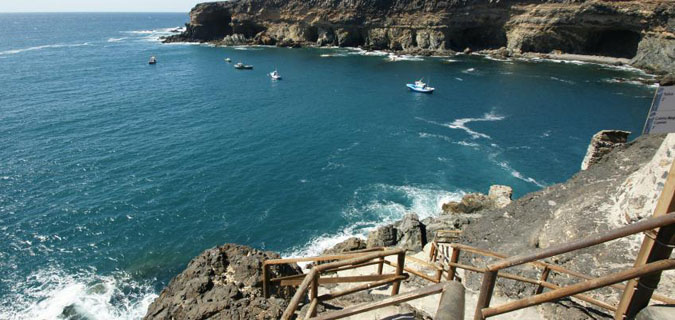 drill
drill
The heart of a small town founded in the 15th century. jest dwunawowa Church of Our Lady of the Rule z 1687 r. The church is famous for its pediment carved in red stone, where the Aztec motifs are clearly visible (Sun, snake, moon, lew). Such decoration was probably influenced by the long-term contacts of the Canary Islands with South America, in this case, Mexico. Inside the church you can see nice baroque altars and a beautiful wooden Mudejar ceiling.
Buses of the line go to Pajara #9 i 18. Casa Isaitas invites you to stay overnight, which offers just four tasteful rooms in a beautifully restored traditional building. The owners of this small hotel also run a good and affordable restaurant. You can also eat tasty food in La Fonda and Los Deportes near the church.
Ajay
A small fishing village west of Pajara has long ceased to be a secret known only to the islanders.
In recent years, it has gained in popularity and is visited by more and more tourists, however, not yet enough, to obscure the natural charm and tranquility of this place. Although the colorful houses by the black volcanic beach look very picturesque, the caves hollowed out by the water are the real treasure of the settlement, accessed by a narrow path along the coast.
You can only get to Ajuy by your own means of transport.
Several restaurants are available on site, in which they serve fresh "fish of the day".
„American Star”
After a few days of a heavy storm in the Atlantic, 18 February 1994 r. the American passenger ship American Star has landed on Garcey Beach on the west coast of Fuerteventura”. Built in 1940 r., after a few days it broke in half. The stern slumped into the ocean, while the bow continues to stick out of the water, being an interesting tourist attraction for some and a macabre mistake for others. From year to year, less and less remains from the hull – only small fragments of the side.
The wreck is located near the military zone, therefore, access to it is somewhat difficult. 2 km before Pajara from the FV-617 road you have to turn left, into an unpaved field road. The route is passable, however, you have to be very careful and remember about it, that in the event of any damage to the car from the rental company, the repair costs must be covered out of your own pocket. You have to go straight, and after the sign informing about entering the Espacio Natural Protegido area, turn left. A few hundred meters away, there is a place to park your car, from which the wreck can be seen best.
Vegas of Rio Palmas
The Spanish word vega means a fertile meadow, and indeed, a surprising patch of lush greenery can be seen from the vantage point on the road above this small town. There is a nice little church in Vega de Rio Palmas, however, he is not the main attraction here. A narrow asphalt road leads south, to a small water reservoir surrounded by greenery and palm trees. Along its western shore there is a trail leading through the stone Baranco de las Peńitas to a small chapel, where the statue of the island's patron is kept, Virgin of Pena. Some say, that the statue of the Virgin Mary was brought to the island by Jean de Bethencourt himself. On the third Saturday of September, the people of Fuerteventura and other islands of the archipelago make pilgrimages to the chapel.. This is one of the biggest and funniest fiestas on the island, during which a colorful procession takes place, similar to the October celebrations of St.. Michael the Archangel in Tuineje.
There is a bus to Vega de Rio de Palmas three times a day #2. There is a Don Antonio restaurant in the village.
Betancuria
Betancuria is undoubtedly the most beautiful town of Fuerteventura, perhaps the only ones really worth visiting. The town delights from afar - the white buildings contrast beautifully with the surrounding cinnamon hills and the almost always blue sky. Today he only lives in Betancuria 600 people, however, it is already visible at first glance, that the town has had years of true splendor behind it. He put them on, baptized with his name and made the capital Jean de Bethencourt in 1405 r. – wyspy conqueror. Placing the capital inland was, according to de Bethencourt's intention, to protect it from attacks by Berber pirates. Protection was inadequate, because the corsairs raided the city several times.
Betancuria is literally three streets and a square, next to which the Iglesia de Santa Maria grows, rebuilt in 1691 r., after v 1593 r. the first temple was destroyed by pirates. The ticket also allows you to visit the Museo de Arte Sacro a few blocks away (Museum of Sacred Art), in which you can see, among others. the flag of the conquistadors, possibly belonging to de Bethencourt himself. In turn, in the archaeological and ethnographic Museo de Betancuria, artifacts belonging to the world of Majos have been collected, maps and documents related to the history of the town, weapons etc..
On the main road VF-30, 5-10 A min walk north of the town, there are picturesque ruins of a Franciscan monastery, founded in 1414 r.
Recently, you can stay overnight in Betancuria – The friendly owners Casa Princess Arminda offers rooms in a beautifully restored building, who also run a small and inexpensive restaurant. It is said that the building housing the hotel and restaurant has been in the hands of the family continuously since the 15th century. There is a good Casa de Santa Mana restaurant in the church square.